Seeds: Types, Selection, and Essential Information
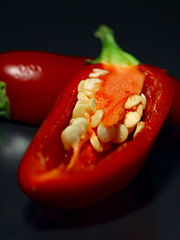
Introduction to Seeds
 A seed, sometimes referred to as a kernel, is a small embryonic plant enclosed in a seed coat, typically containing stored food. It forms from the ripened ovule after fertilization in gymnosperms and angiosperms. This process completes the reproduction cycle in seed plants, starting with flower development and pollination, leading to an embryo from the zygote and a seed coat from the ovule's integuments.
A seed, sometimes referred to as a kernel, is a small embryonic plant enclosed in a seed coat, typically containing stored food. It forms from the ripened ovule after fertilization in gymnosperms and angiosperms. This process completes the reproduction cycle in seed plants, starting with flower development and pollination, leading to an embryo from the zygote and a seed coat from the ovule's integuments.
Seeds have significantly advanced plant reproduction compared to mosses, ferns, and liverworts, which do not produce seeds. This evolutionary step allows seed plants (both gymnosperms and angiosperms) to dominate various land environments, from forests to grasslands, in diverse climates.
Seed Structure
A typical seed comprises three parts: an embryo, a nutrient supply for the embryo, and a seed coat.
- Embryo: An immature plant that will develop under proper conditions. It includes the cotyledons (seed leaves), radicle (embryonic root), plumule (embryonic shoot), epicotyl (stem above cotyledon), and hypocotyl (stem below cotyledon).
- Nutrient Supply: Varies by plant type. In angiosperms, it's the endosperm, rich in oils or starch and protein. In gymnosperms, it's part of the female gametophyte. Some seeds are exalbuminous (no endosperm at maturity) like beans and sunflowers, while others are albuminous (with endosperm) like grasses and palms.
- Seed Coat: Develops from the ovule's integuments, protecting the embryo from damage and dehydration. It can range from thin (e.g., peanuts) to thick and hard (e.g., coconuts).
Some seeds also have appendages like arils or elaiosomes, aiding in dispersal, or features like hairs (e.g., cotton) for protection.
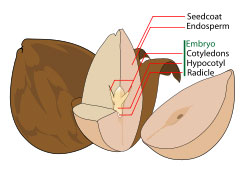
Seed Production and Development
Seeds are produced by gymnosperms ("naked seeds") and angiosperms ("enclosed seeds"). Angiosperm seeds form within fruits, while gymnosperm seeds develop on cone bracts. Key development steps include:
- Double Fertilization: In angiosperms, forming a zygote and a triploid endosperm.
- Seed Coat Formation: From the ovule's integuments, providing a protective layer.
- Embryo and Endosperm Development: Supplying nutrients for the emerging seedling.
Seed Development Stages
Seed development in angiosperms involves three genetically distinct components: the embryo, the endosperm, and the seed coat. The embryo results from the zygote, the endosperm from double fertilization, and the seed coat from the maternal tissue. The development starts with double fertilization, forming a zygote and a primary endosperm. Initially, the zygote remains inactive while the endosperm rapidly divides to form the nutrient-rich tissue. The seed coat forms from the integuments, creating the protective outer layer.
In gymnosperms, only one sperm fertilizes the egg, forming an embryo. The other sperm cell is not used. The resulting seed comprises the embryo and maternal tissue, with conifer seeds enclosed by cone scales.
The ovule's shape often influences the final seed shape. Ovules can be anatropous (curved), orthotropous (straight), campylotropous (curved embryo sac), or amphitropous (partly inverted). The zygote's first division establishes embryo polarity, with the chalazal pole becoming the main growth area and the micropylar pole forming the suspensor.
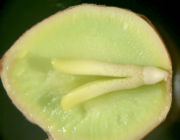
Seed Size and Functions
Seeds vary greatly in size, from tiny orchid seeds to large coco de mer seeds. Smaller seeds ripen quickly and can disperse sooner, while larger seeds contain more energy reserves, aiding seedling establishment. Key functions include:
- Nourishment: Providing essential nutrients to the embryo.
- Dispersal: Using various mechanisms to spread seeds.
- Dormancy: Delaying germination until conditions are favorable.
Seed Size Variations
Orchid seeds are among the smallest, with around one million seeds per gram, relying on mycorrhizal fungi for early nutrition. The coco de mer, weighing over 20 kg, produces fewer but larger seeds with significant energy reserves. Plants producing smaller seeds, like annuals, generate many seeds to ensure some find favorable growth conditions. Larger seeds, common in perennials and woody plants, support more established seedlings with better growth prospects.
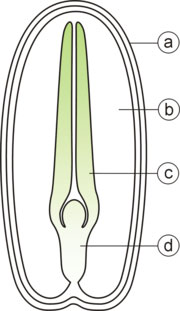
Seed Dispersal Mechanisms
Seeds employ diverse dispersal strategies:
- Wind (Anemochory): Seeds like dandelions and maples travel long distances by wind.
- Water (Hydrochory): Seeds such as Mucuna float and disperse via water.
- Animals (Zoochory): Seeds with hooks or fleshy coverings attach to animals or are eaten and later excreted.
Specific Dispersal Strategies
Wind Dispersal: Many seeds have adaptations like wings or hairs to aid in wind dispersal. For instance, maple seeds have wing-like structures, and dandelion seeds have fine hairs.
Water Dispersal: Buoyant seeds, like those of the sea bean, can travel via water currents and wash up on distant shores.
Animal Dispersal: Some seeds have barbs or hooks to attach to animal fur, while others, like berries, are consumed and later excreted by animals, aiding in dispersal.
Myrmecochory, or seed dispersal by ants, involves seeds with nutrient-rich appendages called elaiosomes. Ants carry these seeds to their nests, consume the elaiosomes, and discard the seeds, facilitating germination.
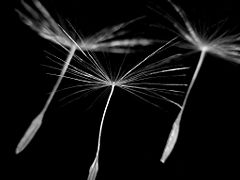
Seed Dormancy and Germination
Dormancy prevents seeds from germinating under unfavorable conditions, ensuring survival. Types of dormancy include:
- Exogenous Dormancy: Caused by external conditions like hard seed coats.
- Endogenous Dormancy: Resulting from internal factors within the embryo.
- Combinational Dormancy: Involving both external and internal conditions.
- Secondary Dormancy: Induced after seed dispersal under unfavorable conditions.
Dormancy Mechanisms
Exogenous Dormancy: Hard seed coats may prevent water and gas exchange, or physically restrict seedling growth. Some seeds have chemical inhibitors that delay germination.
Endogenous Dormancy: Involves immature or underdeveloped embryos that require time to mature. Physiological dormancy requires breaking down chemical inhibitors, often through cold stratification.
Combinational Dormancy: Some seeds have both physical and physiological dormancy, requiring multiple treatments to induce germination.
Secondary Dormancy: Triggered by adverse post-dispersal conditions, secondary dormancy mechanisms are not fully understood but may involve changes in receptor sensitivity.
Inducing Germination
Methods to break dormancy include:
- Scarification: Breaking seed coats physically or chemically.
- Stratification: Moist-chilling seeds to mimic natural conditions.
- Leaching: Soaking seeds to remove chemical inhibitors.
Seed Origins and Evolution
Seeds likely originated in the middle Devonian period. The first "true" seeds appeared in the upper Devonian, leading to the dominance of seed plants in various ecosystems. Early seed plants, like the proto-seed Runcaria heinzelinii, showcased the evolutionary advantages of seeds over spore reproduction.
Edible and Poisonous Seeds
Edible Seeds
Seeds provide essential nutrition, particularly cereals, legumes, and nuts. They also yield cooking oils and spices. For instance, wheat seeds contain gluten, crucial for bread-making.
- Cereals: Wheat, rice, and corn are staple foods providing significant calories globally.
- Legumes: Beans, lentils, and peas offer protein and essential nutrients.
- Nuts: Almonds, walnuts, and cashews are rich in healthy fats and proteins.
Poisonous Seeds
Some seeds contain toxins as a defense mechanism. For example:
- Ricin: Found in castor beans, can be lethal.
- Amygdalin: Present in apple and apricot seeds, leading to cyanide poisoning if consumed in large quantities.
- Lectins and Trypsin Inhibitors: Found in beans, causing distress if not cooked properly.
Toxic Examples:
- Castor Beans: Contain ricin, a potent toxin.
- Rosary Peas: Contain abrin, another dangerous toxin.
- Stone Fruit Pits: Contain amygdalin, which can release cyanide.
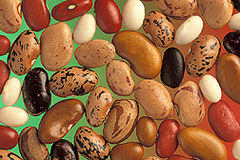
Other Uses of Seeds
Seeds are sources of fibers (e.g., cotton), oils (e.g., linseed oil for paints), and medicines (e.g., castor oil). They are also used in crafting, such as beads for necklaces.
Fiber Sources
- Cotton: The world's most important clothing fiber.
- Kapok and Milkweed: Provide additional seed fibers.
Nonfood Oils
- Linseed Oil: Used in paints and varnishes.
- Jojoba Oil: Similar to whale oil, used in cosmetics and lubricants.
Medicinal Uses
- Castor Oil: Used as a laxative and in various industrial applications.
- Tea Tree Oil: Known for its antimicrobial properties.
Craft Uses
- Job's Tears and Chinaberry: Used in jewelry making.
- Rosary Peas: Though toxic, they are used in traditional jewelry.

